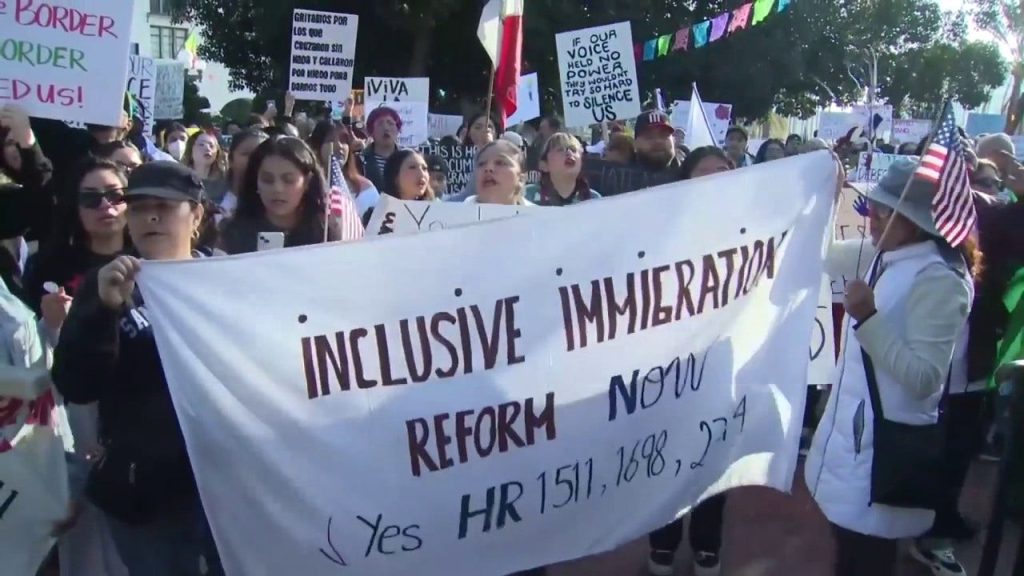On a busy Sunday morning in Los Angeles, hundreds of protesters took to the streets and eventually a major freeway, the 101, to demonstrate against President Donald Trump’s renewed crackdown on illegal immigration. Originating on Olvera Street, a historic and culturally significant location in Los Angeles, the protest quickly escalated, leading to significant traffic disruptions. The Los Angeles Police Department (LAPD) responded by announcing street closures and advising drivers to seek alternate routes. The California Highway Patrol (CHP) echoed these warnings, emphasizing the illegality and inherent danger of using freeways for protests, citing the risk to protesters, motorists, and first responders alike.
The demonstration was visually marked by signs, Mexican flags, and vocal opposition to Trump’s immigration policies. Protest slogans such as “No human is illegal on stolen land” and “Fight ignorance, not immigrants” encapsulated the demonstrators’ core message, challenging the legality and morality of the administration’s actions. The scene was further characterized by the presence of law enforcement officers in riot gear, hinting at the potential for escalation and the authorities’ preparedness for such a scenario. Videos circulating on social media platforms depicted protesters allegedly engaging in acts of vandalism, including graffiti on freeway walls and damage to a vehicle caught in the traffic jam. These actions fueled criticism from conservative commentators, who characterized the protests as disruptive and counterproductive, calling for swift intervention by Immigration and Customs Enforcement (ICE).
Conservative voices online were quick to condemn the protests. Libs of TikTok, a popular conservative account, shared videos of the freeway shutdown, arguing that the demonstrators’ actions were intended to obstruct deportations. The account urged for the involvement of ICE, framing the protests as a deliberate challenge to law enforcement. Similarly, conservative influencer Benny Johnson criticized the protesters, highlighting the illegality of both their presence in the country and their disruption of traffic. He predicted negative consequences for the demonstrators, echoing the sentiment expressed by Libs of TikTok. These online reactions underscored the deep political divisions surrounding immigration policy and the highly charged nature of the protests themselves.
The backdrop to these protests is the Trump administration’s aggressive push to deport illegal immigrants, a policy that has drawn sharp criticism from Democratic leaders. White House Press Secretary Karoline Leavitt announced the commencement of deportation flights, emphasizing the administration’s commitment to enforcing immigration laws and deterring illegal entry. Leavitt underscored the severity of the consequences for those entering the U.S. illegally, framing the deportations as a strong message to the world. The administration’s actions have further fueled tensions and sparked resistance from pro-immigrant groups and activists.
Immigration and Customs Enforcement (ICE) reported significant numbers of arrests and detainers in a short period, indicative of the intensified enforcement efforts. Raids targeting homes, workplaces, and other locations have been reported, as the administration prioritizes the removal of individuals deemed to be a threat to public safety. The administration has stated its intention to send the most violent illegal immigrants to Guantánamo Bay, a controversial proposal that has drawn widespread condemnation. Border czar Tom Homan clarified the administration’s current focus on violent illegal aliens, while Homeland Security Secretary Kristi Noem echoed this sentiment, emphasizing the targeting of the “worst of the worst.” These statements underscore the administration’s prioritization of public safety concerns in its immigration enforcement efforts.
The protests in Los Angeles highlight the ongoing national debate surrounding immigration policy and its enforcement. The clash between the Trump administration’s hardline stance and the resistance from pro-immigrant groups continues to be a source of significant political and social tension. The events in Los Angeles underscore the complex challenges of addressing illegal immigration, balancing enforcement with humanitarian concerns, and navigating the deeply divided political landscape. The responses from various stakeholders, including protesters, law enforcement, and political commentators, reflect the diverse perspectives and high stakes involved in this ongoing national debate. The future of immigration policy and its enforcement remains uncertain, as the Trump administration continues its crackdown amidst ongoing legal and political challenges.

